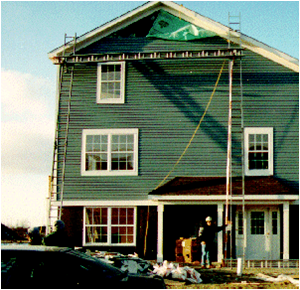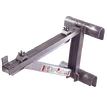Last week I was asked to speak with OSHA at two fall protection awareness sessions in Framingham, Ma. and at National Lumber in Mansfield Mass. In Framingham contractors met an OSHA Compliance Safety and Health Officer from enforcement. In Mansfield the OSHA instructor was a Compliance Assistance Specialist from the education side. Although these sessions do not meet the OSHA training requirements for fall protection, they exposed contractors to the standards that employees and subcontractors must follow working on their job sites.
In each session contractors were shown some of the things they must do to work safe when working at levels 6 feet or more above a lower level (Subpart M). Also contractors were shown they must use fall protection when working 10' above a lower level while on scaffolding (Subpart L). Some of the contractors were noticeably surprised about the rules they must follow.
For example only a couple of contractors in either session knew that you cannot work on ladder jack scaffolds above 20 feet. In the following picture the contractor is using ladder jacks at 26'.

This is a serious unsafe condition that can cause severe injury and will lead to a significant OSHA citation and fine. This height restriction for using ladder jacks is 20 feet.
This can usually be found right on the warning label.  Workers must be trained by a competent person before using this equipment. Also the training must be certified, documented and kept on file in case OSHA wants to see proof that you trained your workers.
Workers must be trained by a competent person before using this equipment. Also the training must be certified, documented and kept on file in case OSHA wants to see proof that you trained your workers.
Here are some of the highlights that OSHA said they are looking for when they drive by residential job sites.
1. Fall Protection; When on a roof or height that is 6 feet or more above the ground they are looking for harnesses and/or guard rails. On harnesses they expect to see an anchor point, full body harness worn properly, rope grab and a properly adjusted line.
2. Ladders; they are looking for ladders that are set at the right angle, set three feet above the edge of the upper work area and the ladders must be tied off.
3. Ladders jacks; they are expecting to see ladder jacks with scaffolds no higher than 20 feet.
4. Ladder jack and scaffold; if working more than 10 feet on scaffolds they are expecting to see full body harnesses with ropes and anchors above or guard rails.
5. Hard hats; when workers are going up and down staging or ladders they need to be protected form falling objects.
6. Guard rails; On scaffolding they are looking for guard rails with top, middle and toe board on the long side and return ends.
7. Access points; They are looking for safe access to upper work areas and staging
8. Openings; They are expecting to see guard rails on large frame openings 6 feet or more above the lower levels.
9. Fall arrest on flat areas; On flat decks they are expecting to see fall arrest and/or guard rails.
10. Proof of Certified Training; when auditing the site the CSHO said he asks to see proof that workers have been trained by a competent person. He said he wants to see a certificate proving the worker is trained on fall protection.
As I spoke to these contractors I found there was a genuine lack of knowledge on what to do to follow the OSHA Fall Protection Standards. The biggest contractor aha moment came when the OSHA Enforcement Officer said he would ask for proof of certified training for people working on the job site. He said that all employers are required to to train their workers and keep a record of that training on a certificate.
Statistics for injuries and deaths from falls have gone up in the residential construction industry. The top cited violation from OSHA is failure to provide fall protection in the residential industry. OSHA has stepped up enforcement in this sector and will continue this effort until the rates of injury and deaths go down.
Until that time, we recommend that you make sure all your employees are trained on Subpart M, L and X and you write a fall protection safety plan with manual. Regarding sub-contractors; we recommend that you require proof from all subs that they are trained and that they provide you with a copy of their written fall protection plan and proof that their workers are certified. Hiring unsafe subs can bring unwelcome attention to your job site and result in potential fines for you.



